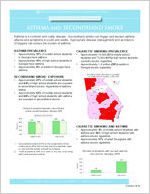The Georgia Department Of Community Health
2010 Georgia Data Summary
ASTHMA and SECONDHAND SMOKE
Asthma is a common and costly disease. Secondhand smoke can trigger and worsen asthma attacks and symptoms in youth and adults. Appropriate disease management and avoidance of triggers can reduce the burden of asthma.
ASTHMA PREVALENCE Approximately 11% of middle school students
in Georgia have asthma
Approximately 11% of high school students in Georgia have asthma
Approximately 9% of adults in Georgia have asthma
CIGARETTE SMOKING PREVALENCE Approximately 19,000 (5%) middle school
students and 72,000 (17%) high school students currently smoke cigarettes
Approximately 1.4 million (20%) adults in Georgia smoke cigarettes
SECONDHAND SMOKE1 EXPOSURE Approximately 57% of middle school students
and 64% of high school students are exposed to secondhand smoke, regardless of asthma
status
Approximately 63% of middle school students and 68% of high school students with asthma are exposed to secondhand smoke
Percent Percent
Percent of students exposed to secondhand smoke, by asthma status, Georgia, 2009
Asthma No Asthma
80%
63%
60%
54%
68% 62%
40%
20%
0% Middle School
High School
1. Secondhand smoke (SHS) is the combination of the smoke given off by the burning end of a cigarette, cigar, or pipe and the smoke exhaled by smokers.
2. Youth exposed to SHS in a room, or in a car, or by living with someone who smokes.
CIGARETTE SMOKING AND ASTHMA Approximately 4% of middle school students with
asthma and 16% of high school students with asthma smoke cigarettes
Approximately 17% of adult Georgians with asthma smoke cigarettes
Percent of students with current asthma who smoke, Georgia, 2009
20% 15% 10%
5% 0%
4% Middle School
16% High School
2 Peachtree Street, Atlanta, Ga 30303 w www.dch.georgia.gov
October 2010
2010 Georgia Data summary | Asthma and Secondhand Smoke
Rate per 100,000
HEALTH BURDEN Over 54,000 visits to the emergency room
and over 10,000 hospitalizations resulted from asthma in Georgia in 2007
Hospitalization rates were highest among young children and older adults
On average, from 2001 to 2007, there were
113 asthma deaths per year for all ages
Asthma hospitalizations by age group, Georgia, 2007
300 250 228
239 240 212
200
150
120
125 140
100 50
79 34 49
0 0-4 5-14 15-24 25-34 35-44 45-54 55-64 65-74 75-84 85+
Age Group
Asthma age-adjusted death rates, by race and sex, Georgia, 2001-2007
5
4
2.9
3
2.3
2
1.2
1
0.7
0 White Males White Females Black Males Black Females
ASTHMA PREVENTION AND EXPOSURE TO TOBACCO SMOKE Despite the fact that smoking may trigger
asthma attacks, youth and adults with asthma continue to smoke Exposure to secondhand smoke increases the frequency and severity of asthma attacks Stopping smoking and limiting exposure to secondhand smoke can help reduce the frequency and severity of asthma attacks
ASTHMA PREVENTION Know the common triggers Exposure to the following environmental irritants and allergens can cause an asthma attack: Tobacco smoke Dust mites Pets (animal dander) Cockroaches Fungi and molds (indoor and outdoor)
Take control of asthma Reduce exposure to your triggers Work with your doctor to create an asthma
management plan Monitor your breathing and airways with a peak
flow meter, as recommended by your doctor Treat symptoms early Learn when to seek medical help
Create an asthma management plan An asthma management plan is a written guide set up by your doctor and you to help manage your asthma, based on your individual needs. Your plan will tell you: What brings on your asthma symptoms How to avoid triggers and reduce exposure What medicines to take and when to take them When you need to seek medical help
Tips for using an asthma management plan: Go over each step of the plan with your doctor Understand instructions for medications Learn to use equipment, such as nebulizers,
properly Schedule routine visits to discuss your asthma
with your doctor Let your doctor know if your plan is not working,
so that the plan can be revised as needed
Data sources:
1. 2008 Georgia Behavioral Risk Factor Surveillance System (BRFSS) (http://health.state.ga.us/epi/brfss/publications.asp).
2. 2009 Georgia Youth Risk Behavior Survey (YRBS) (http://health. state.ga.us/epi/cdiee/studenthealth.asp).
3. 2009 Georgia Youth Tobacco Survey (http://health.state.ga.us/epi/ cdiee/tobaccouse.asp).
4. 2007 Georgia Vital Statistics 5. 2007 Georgia Emergency Department and Hospital Inpatient
Discharge Data
Visit http://www.health.state.ga.us/epi/cdiee/asthma.asp for more information about asthma in Georgia.
Visit http://www.health.state.ga.us/epi/cdiee/tobaccouse.asp for more information about tobacco use in Georgia.
Rate per 100,000
